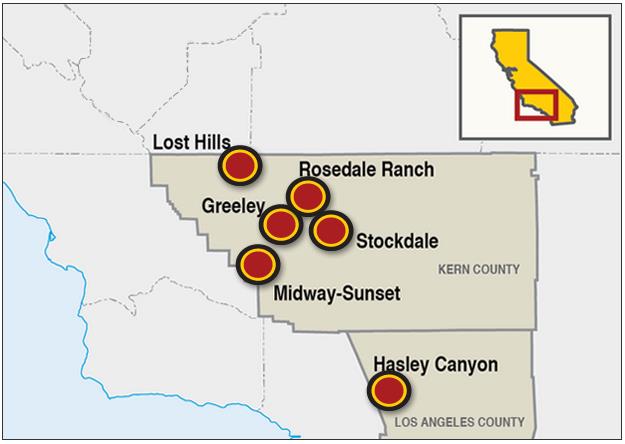Operations
Crimson Resource Management has assembled a vast inventory of long-lived resources in California, some of which have been in its portfolio for more than 25 years. The Company has built an enviable position in the San Joaquin Basin that has substantial growth potential and provides steady cash flow.
The assets are located in large mature oil fields with low-declines that were originally explored or developed by California’s largest oil companies. Crimson targets assets that have substantial bypassed and overlooked oil pay zones, and pursues opportunities to increase returns by making engineering and technical enhancements to production and drilling operations.
As of November, 2019, Crimson was producing 7,978 barrels of oil equivalent per day, the majority of which was from Tertiary Period formations, in Kern, Los Angeles and Fresno Counties, California.
As of November, 2019, Crimson was producing 7,978 barrels of oil equivalent per day


Midway-Sunset

Greeley

Rosedale Ranch

Stockdale

Hasley Canyon

Lost Hills
Major Operated Fields
Lost Hills:
The Lost Hills Field is located about 45 miles northwest of Bakersfield in Kern County, California. Discovered in July 1910, oil production from the Lost Hills Field is from five producing zones, the Tulare, the Etchegoin, the Reef Ridge, the Cahn and the Carneros. Crimson’s operations in the Lost Hills Field is located on the northern end of the field and production in this area is from the Tulare and Etchegoin zones. Steam injection is employed to enhance the production of the 11 to 18 API gravity oil.
Midway-Sunset:
The Midway-Sunset Field is one of the top 10 producing oil fields in the United States, and having been discovered in 1890, it has produced for over 100 years. Crimson’s operations in the Midway-Sunset Field are located on the northern and southern end of the field.
The north Midway-Sunset acreage is located along Highway 33, near the town of Fellows. Crimson operates five separate leases, all below 20 degree API. One of the properties is a Tulare steamflood project Crimson commenced development in 2013. First oil for the steamflood was 2014 and Crimson continues to develop the acreage and increase production.
The south Midway-Sunset acreage is located southeast of Maricopa, north of Western Mineral Road. All the acreage is on primary production at this time. Crimson is looking toward re-establishing one of the properties back to thermal status.
Greeley:
The Greeley Field is located west of Bakersfield in Kern County, California. Discovered in December 1936, production from the Greeley field is from three producing zones, the Rio Bravo-Vedder, the Olcese and the Stevens. This is a deep, light oil gravity play with a strong water drive. Crimson also operates a gas plant at Greeley that processes the produced gas for market.
Rosedale Ranch:
The Rosedale Ranch field, located in the southern San Joaquin Valley, six miles northwest of Bakersfield in Kern County California, was discovered in March 1945. It lies a mile east of the Greeley oil field. Production is from multiple sands in a stacked pay deposition including the Etchegoin, Chanac and Santa Margarita formations. This primary production field has been reinvigorated with the discovery and successful production of the deeper Santa Margarita formation in 2010. Crimson has recently drilled 11 wells to the Santa Margarita formation to date as it continues to delineate the reservoir.
Stockdale:
The Stockdale Field is located south of Bakersfield, Kern County, California. The old area of the field was discovered in January 1962, but the eastern Panama Lane area, which Crimson owns, was discovered in March 1984. The productive zones, called the Upper, Middle and Lower Nozu sands are a member of the Round Mountain formation (middle Miocene) of a depth of about 11,000 feet. These sands are Turbidite sands typical of a fan deposit. Recent drilling has been successful on this deep, light oil play as Crimson continues to delineate the aerial extent of this field. Crimson operates all of the wells in the Stockdale Field.
Hasley Canyon:
The Hasley Canyon Field is located west of Interstate Highway 5 in Los Angeles County, California. The discovery well was completed in December 1944. The productive zones, called the Val Verde Sands, are Turbidite sands typical of a channeled suprafan complex. They are a member of the Modelo formation (uppermost lower Mohnian stage) at a depth of about 4,500 feet. The field has downspace potential to produce the 10 degree API crude. Crimson has drilled 4 wells since it purchased the property to increase the total recovery from the field.
